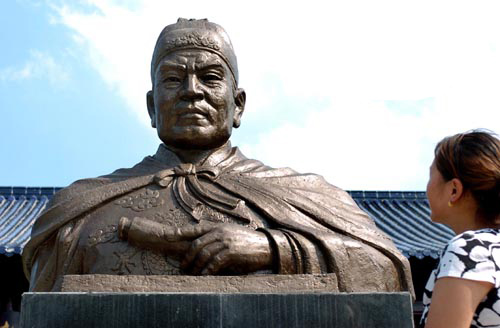Navigator left global legacy

The pictured is a statue of Zheng He in front of the Zheng He Tomb in Nanjing, Jiangsu Province.
This year marks the 610th anniversary of the first voyage to the West commanded by Zheng He, a renowned navigator and diplomat who lived in the Ming Dynasty (1368-1616). Zheng He has been lauded and honored for the tangible and intangible cultural legacy he left in the regions and countries along the route of his marine journeys.
In 1405, during the reign of Emperor Yongle, Zheng He set off with a huge fleet on a westward journey. Over a span of 28 years, he commanded seven expeditionary voyages, leaving his mark upon more than 30 regions and countries in Asia and Africa.
“Zheng He’s Navigation Map, which Zheng He’s fleet compiled and drew during the expeditions, identifies the locations of all Asian and African countries along his navigation route, measures the length and depth of sea lanes, marks reefs and shoals on the way, and names all the places Zheng He covered,” said Wang Rigen, a professor from Xiamen university.
The marine investigations based on Zheng He’s Navigation Map took place more than 400 years earlier than those conducted by Britain’s HMS Challenger, the first to be credited by historians for carrying out oceanographic surveys, said Shi Ping, director of the Research Institute of Ocean Culture at Shanghai Maritime University.
Leading the large-scale expeditionary activities, Zheng He pushed the marine cause of ancient China to new heights and made important contributions to the marine civilization of mankind, Shi added.
Zheng He’s trip to western oceans revealed the advanced navigational techniques of ancient Chinese culture and promoted trade between China and countries along this route. However, the most notable achievement is the “harmonious” spirit of Chinese culture it represented.
“To this day, the spirit of harmony can be found in the routes of vessels, footprints, cultural relics, folklore and customs in and of the countries involved,” said Qu Jinliang, a professor at the Ocean University of China.
Wan Ming, a research fellow from the Institute of History at the Chinese Academy of Social Sciences, made a comparison between Oriental and Western navigational civilizations in his research paper Reflections on Zheng He Studies.
There were two marine exploration modes and related human communication patterns in the 15th century. The peaceful, stable development model of Chinese sailing stood in stark contrast with the violent, predatory model of the West, according to Wan’s research.
Shi said that this history sheds a lot of light on issues such as cultural inclusiveness, sharing and respect.
The construction of the 21st Century Maritime Silk Road has injected new vigor into Zheng He studies, Shi said, adding that the gradual internationalization of Zheng He studies will help the world understand contemporary Chinese ocean management.
Xie Bizhen, a professor at Fujian Normal University, said that due to the construction of the 21st Century Maritime Silk Road, Zheng He studies have been deepening. In recent years there have been many achievements in land and underwater archaeology.
For example, the Yongle Currency of the Ming Dynasty discovered in Kenya has provided new evidence about the voyage of Zheng He’s fleet, Xie said.
“There are still undiscovered historical documents about Zheng He’s sailing, and extant literature needs further research and interpretation,” said Liu Yijie, deputy editor-in-chief of the Maritime Press.
For example, how the navigational technologies recorded in Zheng He’s Navigation Map were utilized is still a mystery. During his voyages, Zheng He established many trade stations called guan chang. Only the station in Malacca has been confirmed, so it is still necessary to conduct field investigations to find details of those in Sri Lanka and India, Liu said.
Shi pointed out the significance of the cultural legacy Zheng He left overseas and said it was a key historical moment and an important example of people-to-people and cultural exchanges along the 21st Century Maritime Silk Road, just as Zheng He developed tourism culture in places he visited during his expeditions.
Zhang Qingli is a reporter at the Chinese Social Sciences Today.
